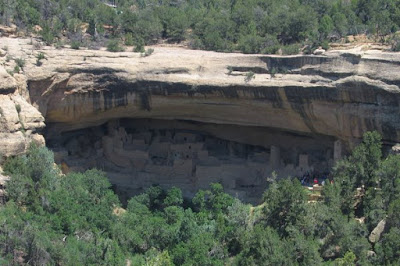
Joe and Ned on a Rocky Mountain High
We had a long full day today. We started off the morning with a talk on the park's bighorn sheep. We learned about how their horns grow and why they come down from the mountains to places like Sheep Lake (it is the minerals in the mud.) After the talk we had an early lunch at the Endovalley Picnic area next to the Fall River before heading up the Old Fall River Road.
The Old Fall River Road was the first road in Rocky Mountain National Park to the park's high country. It was eventually replaced by the Trail Ridge Road and on the park's website they call the Old Fall River Road a "motor nature trail." The road was completed in 1921 and it is narrow and can be a bit steep in parts. It is 11 miles long, gravel, one-way uphill and has many switchbacks. It is not a hurry along road but a slower paced, relax and savor the experience road. It ends at Fall River Pass, 11,796 feet, near the Alpine Visitors Center.
Near the start we passed the alluvial fan scoured out by the 1982 Lawn Lake Flood which flooded part of the park and even the town of Estes Park. We stopped at Chasm Falls and hiked along the river to the spot where it plunged over the rocks and into a chasm. It was a beautiful morning and the rest of the drive was spent just enjoying the views.
When we reached the Alpine Visitor Center we hiked the Alpine Ridge Trail. It leads to the summit of a mountain near the visitor center. It was brisk and windy at the top and we were glad we wore our jackets. We had a quick snack at the visitor center before continuing along Trail Ridge Road. There were some places we wanted to see that we missed on the way into the park. One was at Rock Cut to hike the Tundra Communities Trail. It is just a quick hike through the alpine tundra and at the end there are some great rocks to climb. While the boys climbed I had a conversation with a couple from Rapid City, SD. Mentioning we were head for the Black Hills they told me that it was the start of Sturgis, a huge week long motorcycle rally and I should make sure we had a place to stay.
We also stopped at some overlooks like Many Parks Curve. At Hidden Valley the site of an old ski resort we worked on finishing our Junior Ranger books. When we got to the Beaver Meadows Visitor Center all three of us were able to receive Junior Ranger Badges. Then we drove to Bear Lake a beautiful alpine lake at the base of Hallett Peak and Flattop Mountain. One of Rocky Mountain National Park's most famous and popular trails is the Bear Lake Trail. It combines views of the mountains, the Bear Lake and a short walk, a 0.6 mile loop. It had started to rain a bit when we arrived but didn't last long. Just down the road a bit is the Glacier Gorge Trailhead where we hiked a little under a half mile to Alberta Falls. Glacier Creek thunders down this waterfall which is another of the park's more popular hiking destinations. Since we were there so late in the day we were pretty much alone. It also meant that we couldn't visit some of the other lakes in the area. There were hungry boys to feed.
We returned to the campsite pretty tired and hungry. We got a campfire going and sat around it eating our ramen noodle dinner. Tomorrow we are leaving this beautiful park and going to Denver.

The Bighorn Sheep Ranger Talk

Hiking to Chasm Falls

The Way Up the Alpine Ridge Trail

The Never Summer Mountains

The Trail Ridge Road

Longs Peak

Looking East Along Horseshoe Park

The View From Our Campsite

Picturesque Bear Lake

Joe and Ned at Alberta Falls

























































